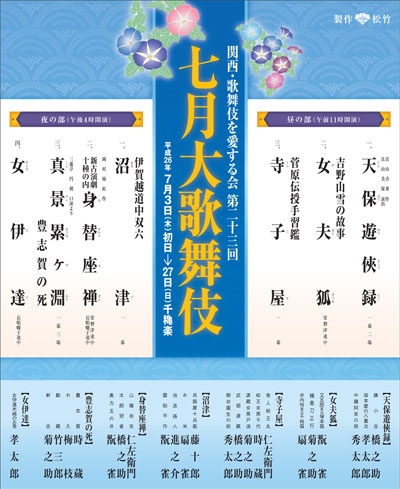| JULY 2014 |
|
3 shows in T˘ky˘ (Kabukiza, National Theatre), 1 in Matsumoto (Matsumoto Performing Arts Centre), 2 in ďsaka (Sh˘chikuza), and 2 tours (Eastern Provinces, Ichikawa Ennosuke Tour)!
|
| Kabukiza (T˘ky˘) |  |
| Dates | 5 ~ 29 July 2014 |
| MatinÚe |
|
| Evening | |
| Casting |
Band˘ Tamasabur˘, Ichikawa Ebiz˘, Kataoka Gat˘, Ichikawa Sadanji, Ichikawa Chűsha, Ichikawa Monnosuke, Ichikawa Ukon, Ichikawa Emisabur˘, Ichikawa Unosuke, Ichimura Kakitsu, Nakamura Kikaku, Kamimura Kichiya, Ichikawa Tsukinosuke, Ichikawa En'ya, Ichikawa Shun'en, Ichikawa Juen, Onoe Ukon, Ichikawa K˘tar˘ |
| Comments |
First performance at the new Kabukiza for the Omodakaya guild along with Living National Treasure Band˘ Tamasabur˘ and Ichikawa Ebiz˘ ... but without the head of the guild Ichikawa Ennosuke.
|
 |
| Sh˘chikuza (ďsaka) |
| Dates | 3 ~ 27 July 2014 (Kansai Kabuki o Ai Suru Kai Shichigatsu ďkabuki) The 23rd Kansai Kabuki Lovers Society July Grand Kabuki |
| MatinÚe | |
| Evening |
Igagoe D˘chű Sugoroku (Numazu) Shinkei Kasane-ga-Fuchi (Toyoshiga no Shi) |
| Casting |
Sakata T˘jűr˘, Kataoka Nizaemon, Nakamura Kanjaku, Onoe Kikunosuke, Nakamura Tokiz˘, Nakamura Senjaku, Nakamura Hashinosuke, Kataoka Takatar˘, Kataoka Hidetar˘, Band˘ Takesabur˘, Kataoka Ichiz˘, Arashi Kitsusabur˘, Kataoka Matsunosuke, Kataoka Shinnosuke, Nakamura Baishi, Nakamura Mantar˘, Nakamura Kotar˘, Nakamura Kunio |
| Comments |
23rd edition of the Kansai Kabuki Lovers Society July Grand Kabuki in ďsaka.
|
 |
| National Theatre (T˘ky˘) |
| Dates | 3 ~ 24 July 2014 (Shichigatsu Kabuki Kansh˘ Ky˘shitsu) July Kabuki Appreciation Class |
| Program |
Keisei Hangonk˘ (Domo Mata) |
| Casting |
Nakamura Baigyoku, Nakamura Kaishun, Nakamura T˘z˘, Nakamura Matsue, Sawamura S˘nosuke, Nakamura Kamenoj˘ |
| Comments |
Educational program at the National Theatre called Kabuki Kansh˘ Ky˘shitu ("Kabuki Appreciation Class"). This is a very interesting formula for the beginners because there is lively presentation of Kabuki (or some aspects of the art like music, stage tricks or fighting scenes) on stage, followed by Chikamatsu Monzaemon's drama "Domo Mata". |
| Kabuki Tour in the Eastern Provinces | |
| Dates | 30 June ~ 31 July 2014 (Sh˘chiku ďkabuki) Sh˘chiku Grand Kabuki |
| Program |
Futatsu Ch˘ch˘ Kuruwa Nikki (Sum˘ba) Keisei Hangonk˘ (Domo Mata) |
| Casting |
Nakamura Kichiemon, Nakamura Shibajaku, Nakamura Matagor˘, Nakamura Kash˘, Nakamura Kinnosuke, Nakamura Karoku, Nakamura Tanenosuke, Nakamura Hayato, Nakamura Yonekichi |
| Comments |
Nakamura Matagor˘ III and his son Nakamura Kash˘ IV celebrate their shűmei touring in the eastern provinces!
|
| Ichikawa Ennosuke Tour | |
| Dates | 9 ~ 21 July 2014 (Ichikawa Ennosuke Tokubetsu Buy˘ K˘en) Ichikawa Ennosuke Special Dance Performances |
| Program |
Zadan |
| Casting | |
| Comments |
A 6-city Buy˘ tour for Ichikawa Ennosuke and Ichikawa Emiya, who do not perform this month at the Kabukiza with the Omodakaya troupe.
|
| Matsumoto Performing Arts Centre (Matsumoto) | |
| Dates | 20 ~ 25 July 2014 (Shinshű Matsumoto ďkabuki) Shinshű Matsumoto Grand Kabuki |
| Program | |
| Casting |
Nakamura Kankur˘, Nakamura Shichinosuke, Onoe Matsuya, Kataoka Kamez˘, Band˘ Shingo, Nakamura Tsurumatsu, Sasano Takashi, Manako Keiji, ďmori Hiroshi, Oida Yoshi |
| Comments |
4th edition in the city of Matsumoto (first time in July 2008; second time in July 2010; third time in July 2012) of a Kabuki program, which is called Shinshű Matsumoto ďkabuki (Shinshű is an old name for the province of Nagano, whose main city is Matsumoto). Same program as the 14th edition of the Cocoon Kabuki in T˘ky˘:
|
|
|
| Contact | Main | Top | Updates | Actors | Plays | Playwrights | Programs | Links | FAQ | Glossary | Chronology | Illustrations | Prints | Characters | Derivatives | Theaters | Coming soon | News |